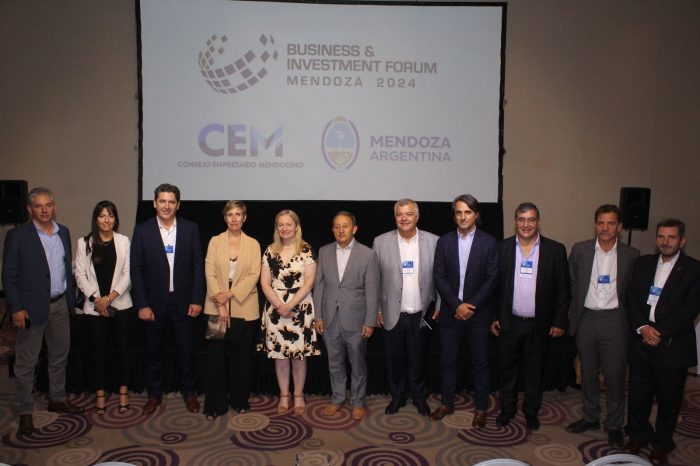Mendoza has the potential, knowledge, and ideal environment for the development of modern and sustainable mining as an engine for development and could become one of the leading producers of the most demanded mineral for future energy transition.
These are some of the conclusions of Pilares, the roadmap presented at the Investment and Business Forum, which took place on February 29 and March 1, gathering more than 4,500 executives and representatives from companies in Argentina and 45 countries, including the United States, Japan, Mexico, Australia, Brazil, the Netherlands, Chile, and Angola.

Within the framework of the forum that brings together over 4,500 entrepreneurs from Argentina and around the world, Pilares was presented, the plan to develop copper, a strategic mineral. The opening of the forum was led by Governor Alfredo Cornejo; the president of the Mendocino Business Council (CEM), Eduardo Pulenta, and the Secretary of Industry and Productive Development of the Ministry of Economy of the Nation, Juan Alberto Pazo. Also in attendance were the Minister of Energy and Environment, Jimena Latorre; the Undersecretary of Energy and Mining, Manuel Sánchez Bandini; the Undersecretary of Environment, Sebastián Melchor; the head of the Mining Directorate, Jerónimo Shantal; the Director of Hydrocarbons, Estanislao Schilardi, and representatives from educational, business, and productive entities.
“Together with the Energy and Environment team, we participated in this forum, where mining activity was proposed as a strategic axis for the province’s development,” Minister Latorre stated.
“These are long-term plans, and it is crucial to highlight that they were developed by the private and academic sectors together with the public sector because it is what society requires, a synergy among all societal actors,” he emphasized.
“The potential Mendoza has in terms of economic and industrial development is in mining,” emphasized Sánchez Bandini. “This is evident in the public’s interest, in the mining forums with full attendance. Mendoza has potential and is initiating a long-term process,” he affirmed.

The mineral with the highest future demand
Pilares sets the roadmap for a Mendoza that has all the conditions to position itself as a central player in the energy transition, which predominantly requires copper. “Let’s bear in mind that a lithium battery only contains 5% of this mineral and 32% of copper. With this study, we see that the opportunity is now,” Shantal expressed.
The work was presented by Osvaldo Urzúa, who, in addition to leading the mining consulting firm Karungen, holds a Ph.D. in Science and Technology Policy from the University of Sussex, UK; an MBA from Esade (Spain), and a degree in Industrial Engineering from the University of Chile.
This is a long-term plan developed between the public and private sectors: Impulsa Mendoza also participated, the tool created by the Government of Mendoza for the development of sustainable mining, the National University of Cuyo, the CEM, and the Mendoza companies Argenteo Mining and Tassaroli.
“Mendoza can leverage its geographic potential, rich geology, human and technological capabilities, and industrial experience and tradition to achieve a leap of prosperity around modern mining development, which will boost the economy and generate quality employment while preserving water basins and ecosystems,” the study states. Additionally, it points out that by 2050, more copper will be needed than what has been produced worldwide since 1900.
“In Argentina, we currently have zero copper production, and we need to close that gap. The formations primarily located in southern Mendoza, which are the same as those in Chile, put us in a position to become one of the main global players in the coming years,” Shantal emphasized.
Green copper
The work emphasizes the demand for minerals extracted sustainably. And the province has the capacity to produce 500,000 cubic tons with only 4 copper projects and 1,500,000 cubic tons with 8 projects that could be developed, according to the preliminary study presented at the forum.
“There are five pillars to make Mendoza a central player. First, conditions to promote investments to understand and develop the resource and maintain operational continuity. Second, linkages, that is, conditions to have productive and reliable suppliers and human capital, and relevant R&D+i. The third pillar is conditions to develop mining with a low water footprint and eco-environmental impact, which helps to address or be resilient to climate change and to recover and preserve ecosystems; the fourth is logistical infrastructure, connectivity, energy, and communications, and the fifth is governance and territorial vocation, i.e., regulatory and control conditions, macro socio-political conditions, and social acceptance and integration in territories that allow attracting investments,” Urzúa explained.
As an essential mineral for clean energy, its exploration and exploitation would be carried out in a sustainable manner, which anticipates a low estimated water consumption (0.8% in years with normal flow), with 80% recirculation and recovery of that water and high international standards. This, along with collective governance committed to society.
Furthermore, it is expected that with the boost to copper, investments only in exploration and studies of four copper projects will reach US$1,332 million by 2050 and, in production, US$12,693 million, that is, about US$470 million annually in the province, with exports of about US$3,150 million per year.
Copper development will also generate more than 2,000 direct jobs and nearly 5,000 indirect jobs, along with the work of service companies and SMEs.
Work meetings
The Energy and Environment team also held work meetings, which will be repeated during the two days of the forum. “We have had a series of meetings with various consulting companies to learn about environmental work lines, complementing business units focused on sustainability, such as solid waste recycling or the regulatory framework for mining productions,” Sebastián Melchor, Undersecretary of Environment, shared.
“During the day, we had meetings in mining, hydroelectric energy, and energy transition with consulting firms and companies interested in investing,” added the Undersecretary of Energy of Mendoza. “On the second day of the forum, work tables will be held with investors in hydrocarbons and energy.”
The meetings include representatives from Potasio Río Colorado (PRC), the largest potassium mine in South America, located in Malargüe; the Argentine Chamber of Renewable Energy, Hierro Indio, Financial Services, and Impulsa Mendoza.



